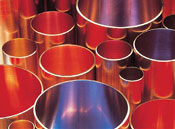Heating and Cooling "Green" With Copper
Over the past decade, the green building movement has grown from a small grassroots initiative to a major influence in building and design. Designers are increasingly required to develop more energy-efficient and environmentally acceptable plumbing, piping and HVAC systems for residential homes and commercial businesses. As a result, builders are taking a more critical look at the systems and materials they incorporate into their projects and designs.
Those intent on building green must take a broad view of life-cycle assessment into account when choosing one material or building product over another. A true assessment goes well beyond initial cost, and even beyond the narrow definitions of USGBC LEED ratings, and consider the overall impact of a product or material on the environment over its useful lifetime.
Copper may be considered the "greenest" of all materials used in plumbing, heating and cooling systems. It can improve the sustainable nature of homes and help commercial buildings achieve green building certification through such attributes as durability, heat transfer efficiency and its ability to be recycled while retaining its key physical properties. By some estimates, as much as 80 percent of all copper that has ever been mined and recovered is still in use today.
One important aspect of green design is controlling waste. Waste in design includes not using key elements to their full capability. Waste can come in many forms, such as wasteful use of electricity and resources as well as operating inefficiencies. With copper, there is little or no waste. All scrap is reclaimed and, in many cases, reused for building projects in one form or another. Recovered copper scrap is a vital raw material in copper plumbing products.
Builders have long relied on the versatility of copper. It is specified for use in most commercial plumbing, and is used extensively as a tubing material in HVAC systems. In addition, it offers several attributes that make it ideal for fire sprinkler systems.
One system for green builders to consider is closed-loop direct-exchange (DX) geothermal heating and cooling. DX systems incorporate copper tubing to effectively harvest the earth's thermal energy for heating and cooling. The system consists of a heat exchanger connected to a network of small-diameter copper tubing buried into the ground. The ambient, constant warmth of the earth is transferred to a heat transfer fluid that circulates through the tubing then back into the building via heating coils and air handlers. In most cases, buildings with DX systems do not require a supplemental furnace or air compressor for heating and cooling.
Water heating is one of the largest energy expenditures for any building or home, but heating water through conventional methods can be energy-intensive and ultimately wasteful. Solar heat exchangers, a highly efficient alternative that absorbs thermal energy from sun (an unlimited free resource) and transfer it to water in the home's storage tank, can be constructed from a variety of metals and some conductive polymers. However, copper is preferred because of its thermal conductivity and excellent resistance to corrosion. This is critical, as these systems are constantly exposed to the elements and can be located in harsh environments.
Hot water recirculating systems that rely on copper tubing for efficient fluid transfer are also gaining in popularity. These systems not only increase energy efficiency, they help to conserve water as well. The most efficient systems are designed to operate only when needed, so energy is not required to circulate water all of the time.
Another option for green plumbing systems is radiant heating that uses copper to circulate water or a heat transfer fluid. Unlike more conventional hydronic or forced-air heating methods, radiant heat systems radiate energy directly to an area's objects and its inhabitants. Because this is a more efficient way to transfer heat, a building can achieve a level of comfort and warmth at a lower overall temperature, saving energy and reducing heating costs.
Builders intent on embracing the green building movement must consider a variety of alternatives to traditional heating and cooling methods. Copper, as one of nature's few renewable finite resources, offers a number of assets to help builders increase efficiencies and reduce energy expenses. Cu
Resources:
Also in this Issue:
- Got Copper (In Your Diet)?
- Copper Ions Keep Roofs Clean
- Heating and Cooling "Green" With Copper
- A Copper Dollar in Your Pocket
- Building Better Bridges

 Copper pipe and tubing is 100% recyclable
Copper pipe and tubing is 100% recyclable